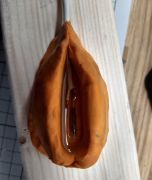|
If you're heating your domestic water with that boiler in addition to central heat, that would explain the high fuel usage.
|
|
|
|

|
| # ? Jun 5, 2024 16:42 |
|
I've got a three-story end-unit townhouse with a new (February 2020) Carrier handler. Texas has hit 100+ for the past two weeks, and as I work from home, ensuring my home office is cool is a high priority. The second and third floors are cooled just fine, but the first floor's office, where I spend most of my day, doesn't get below 80, even with the blackout window inserts and blackout curtains. The airflow is pretty low, too - it doesn't even make ribbons tied to the vent shake. The HVAC tech who came out and looked at the unit said he adjusted our fan speed, and now the unit's performing worse for the rest of the house with minimal change to the first floor. He also stated that the first floor is at the end of a run and it's kind of underpowered to get air to there. The next step he recommended was to install a booster fan in the ductwork. If it were standard flexpipe coming off sheet metal, I could do that, but I'm not familiar with the Knauf EI-800 that's in place. I've mapped out what ducts and runs go to the third floor (it's easy enough), but I only have a hunch about the second floor and the first. I'm thinking that the really thin, long duct coming off the top of the run is what goes to the first floor. It would make sense, as the second floor's cooled pretty well and the other run is substantially larger.  My problem is how would I install a booster fan in that? If it was flexpipe, I could do it, but it's not - it's EI-800 fiberboard, and it looks like it was custom-cut to fit as opposed to some standardized width. I thought about getting into the ductwork from the first floor's ceiling, but no dice - I can't cut open the ceiling or take up the floorboards to get to that (it does end in 8" flexpipe into the vent box, though, so I know at some point it terminates into that). Anyone have any ideas on what the best course of action for me to do about this is? I could simply cut open the run, install a standard booster fan and modify it to securely fit the duct, then seal it back up, but I don't trust myself not to screw that up.
|
|
|
|
Came across this heat pump start-up company earlier today and I'd be curious what folks in here think about it. It's sorely tempting to me since we have a perfect window for it.
|
|
|
|
El Mero Mero posted:Came across this heat pump start-up company earlier today and I'd be curious what folks in here think about it. It's sorely tempting to me since we have a perfect window for it. I'm not proficient in moon units and had to google that 9000 btu is 2.6kW, but that system is essentially the same as what I installed in the house I'm in right now, in that the entire refrigerant loop with all the associated doodads sits outside and all that comes inside is water. What I installed is a 13kW air-to-water heat pump that makes radiator water and tap water, no cooling at all since it only runs the refrigerant "backwards" when de-icing the evaporator. It wouldn't surprise me if the beating heart in that little window unit is a highly conventional Copeland scroll compressor though since that's all I've ever seen on any residential use heat pump I've ever looked at closely. In the Euro market I'm used to a heat pump is a heat pump and the manus mostly compete with name recognition, modern looking designs and fancy apps since their guts are all the same regardless of brand. The only real innovation in the last 20 years is variable RPM compressors which that unit seems to have. The biggest quirk with using water as a heat carrier in a system apart from the added complexity of a water circulation pump and one extra heat exchanger is that you're bringing water outside. This means there's a risk of freezing said water and destroying expensive plumbing bits if something goes wrong (like a blown fuse on a really cold day or something). If you live in a place with cold winters and plan to use this thing for heating as well as cooling I would look into what the manu has done to mitigate that risk. I'm sending hundreds of liters of radiator water out to the heat pump so antifreeze liquid isn't a realistic option for me but maybe they do that? I'd also look into how efficient the unit is C.O.P-wise compared to a similarly sized more regular (i.e. no water involved) mini split. I'd guess it's bound to be worse but probably just a little.
|
|
|
El Mero Mero posted:Came across this heat pump start-up company earlier today and I'd be curious what folks in here think about it. It's sorely tempting to me since we have a perfect window for it. I think it's neat and we'll see more of it. I wonder if the "water" loop is actually a mixture of water and propylene glycol or some such? A system like that could get freeze protection down to 0F with a couple of quarts of relatively inexpensive antifreeze. If it fills a good niche for you and your climate is conducive to it, go for it. If possible see if the company can provide a COP / temperature chart. It'll show you the range of efficiency for the unit, so you can judge the low temperature extreme of your climate and how much reduction in heat you will see. It'll look something like this : 
|
|
|
|
|
If your bringing any cool liquid inside to do the heat exchange, doesn't that mean there's going to be condensation on the inside coils? Where does that water go? I see a tiny drain plug in this diagram: As well as five nebulous connections here:  2, and 3 are electrical connections maybe (power and control) 1 4 and 5 are liquid? refrigerant in/out and then possible a little pump return to bring the condensation water back? Note that window units with this shape already kind of exist  But if course they aren't as engineered, but a common complaint is "I didn't know that they can only run for 30 min before they fill up with water and shut down until I drain it". quote:EDIT: on a very hot and humid day (96*F / 36*C) I started to get FL errors. The condensation tank is full. It averages 4-6 lb water per day. You either put a pot underneath or you empty it out every 1-2 lb when you notice the FL error (I don't know what the capacity of the tank is). On less hot / humid days I didn't notice the tank getting full, but I didn't pay much attention (I'll update the review). quote:After running for few days Iíve noticed that my carpet was soaked with water. Apparently thereís a drainage hole inside the room which was supposed to have a plug but there was no plug . Iíve tried to call manufacturer but no success. I emailed them to send me missing plug also no reply. Iím very disappointed. My hardwood floor discolored. Very disappointed with customer service. Well thereís no customer service. Iím still waiting . Will update my review if anything changes. quote:Love the design concept of this little ac unit. However we did not read all the reviews to find that the condensation builds up in a little reservoir before it begins to over flow all over your floor. The info packet does not spell it out either. Luckily my husband is an engineer and ran a tube/hose outside so we do not have to worry about it. It doesnít take long for the reservoir to fill for this large of a unit.
|
|
|
|
That's an interesting question about the condensate. Do heat pumps generate less condensate than AC units? Or is that something that's entirely a function of the temperature differential between outside/inside?
|
|
|
|
Condensate amount is going to depend on the temperature of the coil, and then outside air temp and humidity. I donít see why a heat pump would run at any different temp than a regular AC unit.
|
|
|
|
Bird in a Blender posted:Condensate amount is going to depend on the temperature of the coil, and then outside air temp and humidity. I donít see why a heat pump would run at any different temp than a regular AC unit. It wouldn't. The only difference between a heat pump and plain air conditioning is the heat pump has the valving and controls needed to change which coil is condensing and which coil is evaporating. In cooling mode it's going to be exactly the same as any other AC.
|
|
|
|
El Mero Mero posted:That's an interesting question about the condensate. Do heat pumps generate less condensate than AC units? Or is that something that's entirely a function of the temperature differential between outside/inside? Condensate is only created by the combustion process of a high efficiency gas heat pump. It is significantly less than what you are likely to see coming off of an evap coil for the same/similar unit running AC. The amount of condensate produced has more to do with the inside humidity/dew point than anything else for AC. If you're talking about a heat pump with a reversing valve no condensate is created when it's in heat mode.
|
|
|
|
Heat pumps don't generate condensate perse, but as they cool they're also pulling moisture out of the air and condensing it into liquid that has to go somewhere, and that's still called condensate.
|
|
|
|
I guess your heat pump could be modulating and absorb heat at a different rate? But for a given coil, but, and whatever other parameters matter, you will get the same amount of condensate no matter if it's a heat pump or just straight a/c.
|
|
|
|
An AC is a heat pump that pumps heat from the inside to the outside. A fridge or freezer works the same way. A heat pump is a heat pump that pumps heat from the outside to the inside. They are all the same only configured to accomplish different tasks. Sometimes they can reverse the flow of the refrigerant to run the other way. This is especially common if they are heat pump heat pumps. Air source heat pumps (which is what we call an AC that makes the outside colder) create lots of condensation on the evaporator side of things if the air that is to be conditioned has certain conditions.
|
|
|
|
Jerk McJerkface posted:Note that window units with this shape already kind of exist WTF are they thinking? Oh, it's Soleus... not worth the plastic the case is made of. I've never seen a window unit that doesn't either drain outside or splash the water onto the condenser coils to help with efficiency (where some will also drip out, but at least it's outside). Midea figured out how to do the U-Shape properly, condensation goes outside. 
|
|
|
|
STR posted:WTF are they thinking? They're thinking this design is great because you can still see out of your window, but didn't realize the design they stole and started manufacturing originally had a condensate pump in it for very good reasons. Because they are very smart this was not included so the unit price became $0.42 lower.
|
|
|
|
FWIW I've had one Soleus air unit. The condensate pump sounded like a million mile Iron Duke with no rod bearings left. The compressor didn't sound much better. It didn't last very long... The no name ("Cool Zone") window unit I have now is far quieter, you only have to yell over it instead of shout. Tl;dr Soleus is loving garbage
|
|
|
|
Geothermal AC trip report: There was a bit of a heat wave last week. Bro was out of town for a few days, came home and turned on the AC. The temp graph from his bedroom looks like so:  It clearly works at cooling the house more or less as intended. We were puzzled at the lack of condensation last time we worked on the thing, but the humidity up to that time had been pretty low. This week the weather turned muggy and the flaws in the unfinished installation have become very apparent. Ain't nobody wants to work in the attic when the sun is shining, but the insulation is very nearly finished (hopefully). Wherever it isn't done it gets real sweaty. The biggest mistake was the connection between the drain hose and the heat exchanger condensation tray which was only finger tight, so a bunch of water leaked out there when the dripping started in earnest. Enough to soak through the 40 cm or so of fiberglass insulation as well as the inner ceiling. Oops. Luckily the insulation in new and clean so there's little risk of anything nasty growing in there before it dries out with a bit of forced ventilation.
|
|
|
|
I forgot, I have some very rough performance numbers: Power consumption at full blast is about 260W; 170W on the blower, 80W on the brine pump and 10W on control. Airflow is roughly 200 l/s which google says is about 420 cfm. When cooling a hot house (say 27įC) the thermal output is about 3.4 kW. If the house is at a more comfortable 22įC the output drops to 2.6 kW or so. Probably not sufficient for a house of the same size in Phoenix or something, but it seems to be about right for Stockholm.
|
|
|
|
Invalido posted:I forgot, I have some very rough performance numbers: I've been watching you post for a while now and somehow I only just now realized that your plan all along was literally just using the brine to cool a heat exchanger and not using it to cool the hot side of a regular heat pump. That's awesome. If my Google-fu is right that's about equal to somewhere in the range of 0.75-1 ton of cooling, which would definitely not be sufficient here in Phoenix, but I'd gladly take a ton of effectively free cooling to reduce the runtime on my five ton heat pump.
|
|
|
|
IOwnCalculus posted:I've been watching you post for a while now and somehow I only just now realized that your plan all along was literally just using the brine to cool a heat exchanger and not using it to cool the hot side of a regular heat pump. That's awesome. This type of system is actually called "free cooling" in Swedish since the C.O.P is so high it is almost free! As I've mentioned previously, residential AC is very uncommon here since the climate doesn't really require it historically, but with climate change and modern architecture with lots of glass this is slowly changing. It's fairly common in larger buildings though - hospitals, office towers, large industries, big box stores and the like. There's a practically limitless supply of cool water at the bottom of the large lake where Stockholm gets its tap water so there's a few limited grids around the city for district free cooling, though it's nowhere near the coverage of the district heating grids. My local hospital is pretty far away from this lake so when they expanded with a new wing they drilled hundreds of geothermal holes under it to sort both heating and cooling. In essence they store summer heat in a large chunk of bedrock and re-use it in the winter. Pretty clever. In bro's case I assume his geothermal hole is "wet" and has water flowing past it since it still puts out good temps even though it's several decades old, but in case it is a dry hole a nice side effect of his system would be slowing down the heat pump cooling of the rock around the hole and prolong its life a little. Measuring anything related to heat in tons of all things is just It would have been possible to install a system 2-3 times as powerful as we did (there is a real limit to brine flow because of the diameter of the hose loop in the well) but we made an educated guesstimation and figured this size would be reasonable. Also the most economical, compact and easy to install - it is a retrofit after all. Only time will tell but early results indicate we got it about right. If it can't quite keep the entire house at 21C during the worst heat wave in history it will still keep things cooler and drier than at the neighbor's house at least. Bedrooms where it's most important can be given priority too of course. In my house I have zero active cooling which is the norm. If there's a heat wave I can always leave my top floor bedroom for the relatively cool comfort of the basement for a time. Right now I'm sitting in front of an open balcony door for ventilation with a screen door installed to keep bugs and the neighbor's evil cat out. It's a cool 22C outside today. Not quite like in Phoenix. It will be interesting to experiment with flow settings and see what happens at lower speeds on blower and pump. I'd hazard that we'd get 80% of max cooling on 50% of the electricity use making the C.O.P even more bananas. The noise levels at full blast is quite tolerable as it is but less noise and more efficiency is of course always more better.
|
|
|
|
IIRC the "ton" of cooling is equal to melting 1 ton of ice per day. It's 12k BTU/hr which is *approximately* 3500 joules/sec.
|
|
|
|
Huh. Makes about as much sense as calories I suppose.
|
|
|
|
kastein posted:IIRC the "ton" of cooling is equal to melting 1 ton of ice per day. It's 12k BTU/hr which is *approximately* 3500 joules/sec. That's exactly right. 288,000 BTU per day, per ton of ice.
|
|
|
|
Chunderbucket posted:That's exactly right. 288,000 BTU per day, per ton of ice. I worked at a place one time that had some 14 pallets of 20 lb bags of ice that there was nothing wrong with but due to a paperwork problem they couldn't be used for food production and had to be destroyed. My plant manager mused if it would be worth it to get them hauled to his house and used to cool down his outdoor pool, which had gotten unpleasantly warm, it being August. We did the math and adding all that ice would only bring his pool down something like 1.3F so in the end we dragged them outside and put them around the smoker's patio and for a day it was positively lovely out there.
|
|
|
|
Invalido posted:I forgot, I have some very rough performance numbers: This is really awesome. Congratulations.
|
|
|
|
El Mero Mero posted:Came across this heat pump start-up company earlier today and I'd be curious what folks in here think about it. It's sorely tempting to me since we have a perfect window for it. For almost $2K, I'd rather modify the window frame/circuit to take a standard PTAC, which could be had for about half that for the unit itself. PTACs are big and clunky, but very reliable, as proven by every <$100/night motel in the country. I'll be interested to see their AHRI cert, but 10.8 EER isn't impressive. Bog standard PTACs do 12 EER all day long and have the option of backup heat.
|
|
|
|
B-Nasty posted:. PTACs are big and clunky, but very reliable, as proven by Lol.
|
|
|
|
So we are looking for a new AC system. We have a four ton system for a 2600 square foot house, unfinished basement not included. We are getting bids and so far one person has said that 4 tons isn't enough and we need 5 tons, and 2 people say that 4 tons is too much based on our duct work, and they recommend 3-3.5. The people saying less seem to be more knowledgeable and are leaving money on the table by going with something smaller, but we are trying to figure out who is full of crap and who isn't. Also, do most HVAC companies only rep one manufacturer? We are trying to get bids and would prefer Trane/Carrier/Rheem, but even though we put that into the request for quote, they are all coming back with companies I have not heard of.
|
|
|
|
Have any of them done a manual j calculation to justify their sizing?
|
|
|
|
Guy Axlerod posted:Have any of them done a manual j calculation to justify their sizing? They measured the duct work coming from the AC/Furnace. The odd part is that house is 18 years old and this is the AC that was installed when it was built. My BIL is a commercial building PM and we asked him and his point was the house should have been spec'ed correctly by the builder. The person that said we needed 5 tons was just a salesperson on the phone who was not sure if the basement square footage would count towards the total, so she just went high, but had no real data to back it up. And actually we just had a 3rd person come and while he has not given us anything yet, part of his spiel was that the AC needed to be sized correctly and it if was too big it would be stopping and starting a lot.
|
|
|
|
SubjectVerbObject posted:They measured the duct work coming from the AC/Furnace. The odd part is that house is 18 years old and this is the AC that was installed when it was built. My BIL is a commercial building PM and we asked him and his point was the house should have been spec'ed correctly by the builder. The person that said we needed 5 tons was just a salesperson on the phone who was not sure if the basement square footage would count towards the total, so she just went high, but had no real data to back it up. A common flaw in thinking I see is "the last guy must have done it right" but in my experience they didn't or the methods and thinking have changed. So having the math done again from scratch is important.
|
|
|
|
SubjectVerbObject posted:My BIL is a commercial building PM and we asked him and his point was the house should have been spec'ed correctly by the builder. lol Your BIL works on the commercial side, where sizing things is done properly because it costs money that the person who owns the building needs to spend on running them. The person who owns the building is likely a professional and knows why this matters, unlike joe prospective new homeowner who's buying the already-built tract house or getting a "custom" build. Some things you may hear from a builder when they have put in the wrong system: "that's just how open concepts houses are, it's only a few days a year", "just leave the fan on all the time", "we put this system in all the time and never have any problems. Have you blocked any vents?"
|
|
|
|
Hey all, I just had my AC system inspected and once again the company recommended a blower wheel cleaning. They wanted $500 or so to do the job, so I decided to get a second opinion on things first. Before the other outfit comes though, I was hoping to get some input on the matter here. Here's the best picture I could manage of the wheel. Really do appreciate your input on this. So, does it warrant cleaning? You can weigh in on the cost too, but I imagine that is a little harder to gauge. It's a Goodman, and it's going on 14 years for what it's worth.
|
|
|
|
If they actually tried to sell you "blower wheel cleaning" at all, never mind for $500 just lose their phone number right now and find someone else. It's much more likely you didn't understand what they were trying to sell you which you may or may not need, but probably do if it's indoor and outdoor coil cleaning and cleaning of the condensate drain.
|
|
|
|
Iím fairly certain it was the blower wheel, but I will ask about those other pieces when the other outfit comes. Roger on losing the other oneís number too.
nitsuga fucked around with this message at 22:07 on Jul 14, 2022 |
|
|
|
That wheel is a bit gross ngl, If its that dirty both coils indoor and out probably need a wash. Also lol at the notion that commercial building owner/operators know anything about hvac, or are immune to "lowest bidder" fallacy.
|
|
|
|
MRC48B posted:Also lol at the notion that commercial building owner/operators know anything about hvac, or are immune to "lowest bidder" fallacy. The (successful) ones I've dealt with have. And even if they don't a commercial building is a lot more likely to have had an engineered system as part of it's design and stamped drawings rather than as an afterthought by unqualified subcontractors brought in sometime during framing.
|
|
|
|
MRC48B posted:That wheel is a bit gross ngl, A commercial building is going to have a PE mechanical engineer design the system, which is a lot more than most houses get.
|
|
|
|
My wife has started doing spreadsheets, and it is just odd how all over the place folks are. The furnaces they are recommending run from half the BTU of our current to the same. Similarly with AC. Prices are different, but the vendor and sizing is so different too that it is hard to compare. I think the main thing I am getting from this thread is that nobody really knows what they are doing. Thanks!
|
|
|
|

|
| # ? Jun 5, 2024 16:42 |
|
C Wire question. I bought a house that has an HVAC from the late 90s. There was a pretty standard cheap Honeywell thermostat installed. We have a smart thermostat we wanted to install. When I removed the old thermostat - I noticed the blue C Wire wasn't hooked up, but was instead coiled back behind the system (not abnormal I know). Along with an orange wire and two black wires. Anyway I popped up into the attic and checked the furnace wiring and it seems like the C wire is hooked up there. The bundle of wires (red, white, yellow, green and blue) all very clearly came out and connected to a very clearly labeled board. Come back downstairs, wire everything up and the smart thermostat won't power on. I doubled checked everything and all seemed totally fine. It just wouldn't power on. I put the old system back in and tried it with the C wire just to see. It didn't work either. Popped the batteries back in and we're back to operating. So, I didn't take pictures like a dumbass but I'm going to get back up there this weekend and poke around some more. Is there anything specific that I should be looking for to ensure the c wire is correctly attached? Something a novice might overlook? Because it sure seems everything is connected right. Just the C wire isn't providing power. And I'll grab some pictures this time too.
|
|
|





























